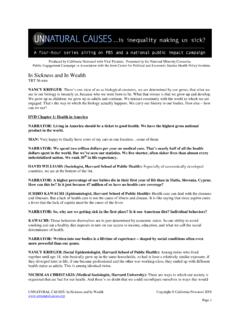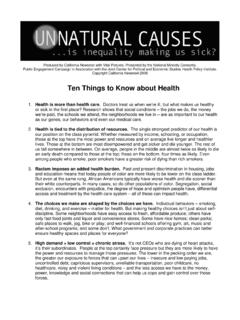Transcription of When the Bough Breaks final - CALIFORNIA …
1 UNNATURAL CAUSES: when the Bough Breaks Copyright CALIFORNIA Newsreel 2008 Page 1 Produced by CALIFORNIA Newsreel with Vital Pictures. Presented by the National Minority Consortia. Public Engagement Campaign in Association with the Joint Center for Political and Economic Studies health Policy Institute. when the Bough Breaks TRT 29 min DVD Chapter 1: Race Gap NARRATOR: Several years ago, two physicians in Chicago set out to solve a mystery: why do African American women have babies that are born too small, at twice the rate of white American women? Richard David and James Collins are neonatologists -- pediatricians who specialize in the care of infants who come into the world too early or dangerously underweight and often both. Like virtually everyone in their field, they were troubled by the striking racial differences in rates of premature and low birth-weight babies.
2 What could account for the differences? JAMES COLLINS (Neonatologist, Children s Memorial Hospital, Chicago): Originally I thought that the disparity in premature delivery was really driven by socioeconomic differences between African Americans and whites. It s well known that African Americans have a lower, collectively, socioeconomic status than whites; they re less likely to receive college education than whites. So I thought once you corrected for that, that the gap would go away. NARRATOR: But Collins and David discovered the gap didn t go away. COLLINS: We were very surprised to find that the gap actually widened as education and socioeconomic status improved and then began to look at it from a bigger perspective and broader perspective, and really started to realize, well maybe it s something about lifelong minority status which is the driving factor here.
3 RICHARD DAVID (Neonatologist, Stroger Hospital of Cook County, Chicago): There s something about growing up as a black female in the United States that s not good for your childbearing health . I don t know how else to summarize it. NARRATOR: So the two neonatologists began to explore whether being a member of a particular minority group might affect pregnancy outcomes, and they came up with a controversial hypothesis. What s behind the low birth weight and premature birth for African American babies is the unequal treatment of African Americans in American society. In other words, racism is taking a heavy toll on African-American children even before they leave their mother s wombs. It s an idea that s slowly gaining acceptance. R. DAVID: We re in the midst of a paradigm shift. 15 years ago, racism as a risk factor was almost never heard of in a scientific paper; whereas now it s much more a possibility.
4 DVD Chapter 2: Kim Anderson s Story NARRATOR: The story of Kim Anderson, a successful Atlanta executive and lawyer illustrates exactly what David and Collins are talking about. We know that a healthy lifestyle should lead to a healthy baby. Women who eat well, exercise, get prenatal care, avoid alcohol and drugs, and cigarettes are more likely to have a good pregnancy. But one of the best predictors for a healthy pregnancy outcome is higher education. UNNATURAL CAUSES: when the Bough Breaks Copyright CALIFORNIA Newsreel 2008 Page 2 KIM ANDERSON: This is a picture of me, May 1984, when I graduated from Columbia Law School. People would think I m living the American Dream: a lawyer with two cars, two and a half kids, the dog, the porch, a good husband, great family. I ve always been lucky to have good health .
5 Always ate well. Exercised. Never smoked. NARRATOR: So when we look at Kim Anderson a well-paid lawyer in good health -- we would expect her newborn to be a healthy, full-term baby. It didn t turn out that way. Back in 1990 when she was pregnant with her first child, Kim went into labor two and a half months early. KIM ANDERSON: I just wanted to know at least that if she was born alive, that at least we had a fighting chance. I heard her cry, I said, Thank, God. But she was so small. I mean you could like, hold her in the palm of your hand. NARRATOR: Kim s baby, Danielle, weighed only two pounds thirteen ounces when she was born. She joined the ranks of almost 300,000 low birth-weight infants born in the that year, about 1 out of every 14 babies, all of them at a high risk of dying before their first birthday.
6 KIM ANDERSON: I remember getting home and being in the bathroom, just, I fell apart. You know, cause it s like I didn t get to take my baby home, you know. I remember just sort of falling apart. NARRATOR: Preterm and low birth weight are the leading reasons that the US claims the dubious distinction of having one of the worst infant survival rates in the industrialized world. We fall behind dozens of countries. Babies born in Slovenia, Cyprus, Malta and Croatia stand a better chance of living to the age of one than a baby born here. R. DAVID: It is kind of like the canary in the mine; it s the most sensitive of our health outcome indicators per population. NARRATOR: And infant mortality is not just a problem for African Americans. R. DAVID: White Americans, if they were a separate country, would still rank 23rd in the world.
7 So outcomes are very bad. NARRATOR: As a country we pay an enormous price for our high rate of premature and low birth weight babies. Pre term birth is the second leading cause of death for infants. If they re lucky enough to survive, many face a lifetime of learning and medical problems. Studies show that prematurity increases the risk for hypertension, diabetes and coronary artery disease. And the high cost of their medical care begins the moment they re born. One month s stay in a neonatal intensive care unit averages $68,000 dollars. COLLINS: Neonatology is a lot of things. Inexpensive is not one of them. And we spend a disproportionately high amount of our income as a society taking care of infants, a lot of whose problems probably could have been prevented if they had stayed in the womb until term.
8 NURSE: Her current weight today, mom, is 2 pounds, ounces. MOM WITH PREMIE: Ok. NURSE: Ok? So she s gaining, she gained 15 grams from yesterday. MOM WITH PREMIE: This is my first child, so I was like just amazed, y know, and I was, I was a little shocked. I have never seen a child this small before - never. It just took me away, but you see how she is now she s 2 pounds. So, miracles do happen. Everyday. UNNATURAL CAUSES: when the Bough Breaks Copyright CALIFORNIA Newsreel 2008 Page 3 DVD Chapter 3: SES, Genes, & health NARRATOR: In the terminology of social scientists, Kim Anderson s family enjoys high socioeconomic status, which increases the odds for overall good health . DAVID WILLIAMS (Sociologist, Harvard School of Public health ): Persons who are higher in socioeconomic status, persons who have more income or more education or better jobs or more wealth, live longer, and have fewer health problems than those who are lower in socioeconomic status.
9 CAMARA PHYLLIS JONES (Medical Epidemiologist, Centers for Disease Control and Prevention): Education, for example, predicts infant mortality for both black women and white women. And the more educated you are, the less likely you are to have a low birth-weight baby, a preterm baby, or an infant death. NARRATOR: Women who are poorest and least educated are those whose babies are at greatest risk in any racial group. But the babies of African American mothers with higher education are still at greater risk than we d expect. Infant mortality among white American women with a college degree or higher is about 4 deaths per thousand births. But among African American women with the same level of education, infant mortality is about 10 per thousand births almost three times higher. In fact, African American mothers with a college degree have worse birth outcomes than white mothers without a high school education.
10 MICHAEL LU (Obstetrician, David Geffen School of Medicine, UCLA): Think about this. We re talking about African-American doctors, lawyers, and business executives. And they still have a higher infant mortality rate than non-Hispanic white women who never went to high school in the first place. KIM ANDERSON: As a mother you re thinking: I did all the right things. They told me to take vitamins; I took vitamins. They told me to walk. They told me to eat vegetables. They told me not to drink. I didn t do all that, and why is my kid sitting here with these needles and, you know, so you feel real helpless. You really feel helpless. NARRATOR: So Doctors Collins and David asked themselves if the answer could possibly be genetic it s well known that prematurity can run in families. Is there something in the DNA of African American women that tends toward premature births regardless of education, prenatal care, or lifestyle?







